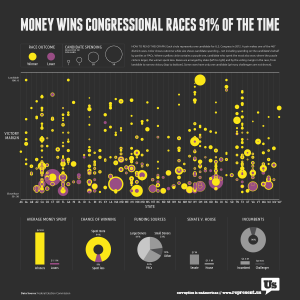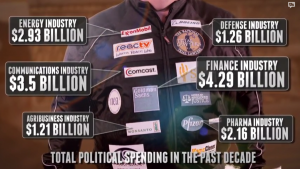Political transparency
Politicians get into power by campaigning. The better funded a campaign the more likely a candidate is to get into office[1](see Figure 1). A prime source of funding are corporations, however, they exist to make money, therefore, these donations always come at a price.
In Australia, public funding for campaigning has been widely debated[2]. There is a common understanding that transparency is good, similar to how CCTV reduces crime by inducing the fear of being watched. As such the Australian Electoral Commission (AEC) publishes some open data about political donations[3] and Google openly publishes its ad revenue from politicians[4]. This data is widely available but is difficult for the public to digest (see our attempt below) and is flawed in its inception as third parties often donate via shell companies and only donations under $13,800 need to be declared. This leads to large donors circumventing the intention of the law by splitting large donations into smaller chunks. For example, Zali Steggal received $100,000 from the coal millionaire John Kinghorn who when questioned said that it was one cheque which was a split donation from 8 of his family members[5].
Ideally for the public to fully understand who is pulling the strings it should be mandated that all politicians wear badges much like sportsmen wear the brand of the company that is sponsoring them (see image to the right). Alternatively, we could adopt a very simple, proven change which would reduce the influence corporations have on our democracy, ban direct corporate sponsorship and implement a voucher system so that everyday voters can contribute to parties whilst getting rid of corporate influence.
This would not be a leap in the dark as democracy vouchers via the American Anti-Corruption Act have been used as a method of public financing of political campaigns for many years in the United States. It was approved in 2015 and debuted during the 2017 election cycle in the municipal elections in Seattle and Washington. The program provides city residents with four vouchers, each worth $25, that can be pledged to eligible candidates running for municipal offices. The scheme is funded by a property tax and is applied on a first-come, first-served basis.
Australian Electoral Data
The data released by the AEC brings some light to the matter, however a lot are dead ends. It seems donors can sometimes hide their identities behind associated entities[6].
Graph 1: Donations made to each politician.
Out of 151 MPs and 76 senators, 40 have disclosed donations to their campaign. This graph, breaks down the donations given to individual MPs by their source. Additionally, you can type in a name of an Australian political candidate and it will show who their main financial contributors are. By looking generally at the data an anomaly instantly pops out, Steggal. Although 1378 donations were made to the Steggal campaign, only 13 donations had names attached, only $350,726 of the $1.1 million in donations the Steggell campaign pulled in is accounted for under current electoral laws - about a third[7].
Graph 2: Third Party Return Expenditure.
Graph 3: Third Party Return Donations Received.
This graph shows you individual MPs
Graph 4: Third Party Return Donations Made.
This graph shows you individual MPs
Graph 5: Senate Groups and Candidate Return Summary
This graph shows you individual MPs
Graph 6: Senate Groups and Candidate Expenses
This graph shows you individual MPs
Graph 7: Senate Groups and Candidate Donations.
This graph shows you individual MPs
Graph 8: Media Returns.
This graph shows you individual MPs
Graph 9: Media Advertisement Details.
This graph shows you individual MPs
Graph 10: Donor Return.
This graph shows you individual MPs
Graph 11: Donor Donations Received.
This graph shows you individual MPs
References
- ↑ Represent.US: https://visual.ly/community/Infographics/politics/how-money-won-congress
- ↑ https://www.aph.gov.au/Parliamentary_Business/Committees/Joint/Completed_Inquiries/em/political_funding/Report/Chapter6
- ↑ Annual disclosure return:https://www.aec.gov.au/parties_and_representatives/financial_disclosure/guides/donors/index.htm
- ↑ https://transparencyreport.google.com/political-ads/region/AU
- ↑ ABC News: Zali Steggall defends donations from wealthy family with links to coal industry. Accessed on 16th February. Posted Mon 14 Feb 2022 at 11:56am, last updated Mon 14 Feb 2022 at 12:54pm.
- ↑ The Age: Are our politicians for sale?
- ↑ Canberra Times: Invisible donors: NOVEMBER 5 2019: Big political spenders just the tip of the iceberg. https://www.canberratimes.com.au/story/6473068/invisible-donors-big-spenders-the-tip-of-the-iceberg/

